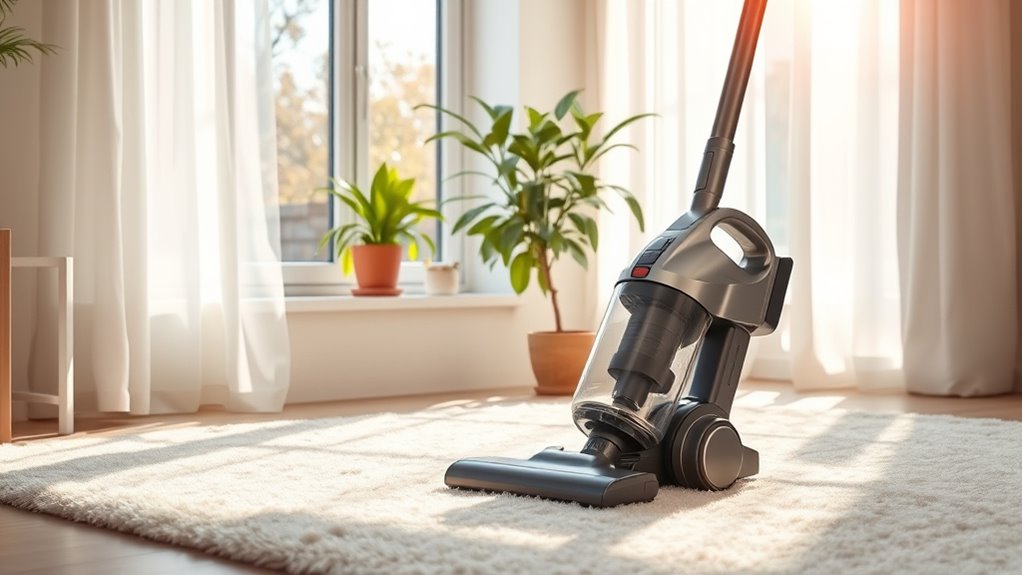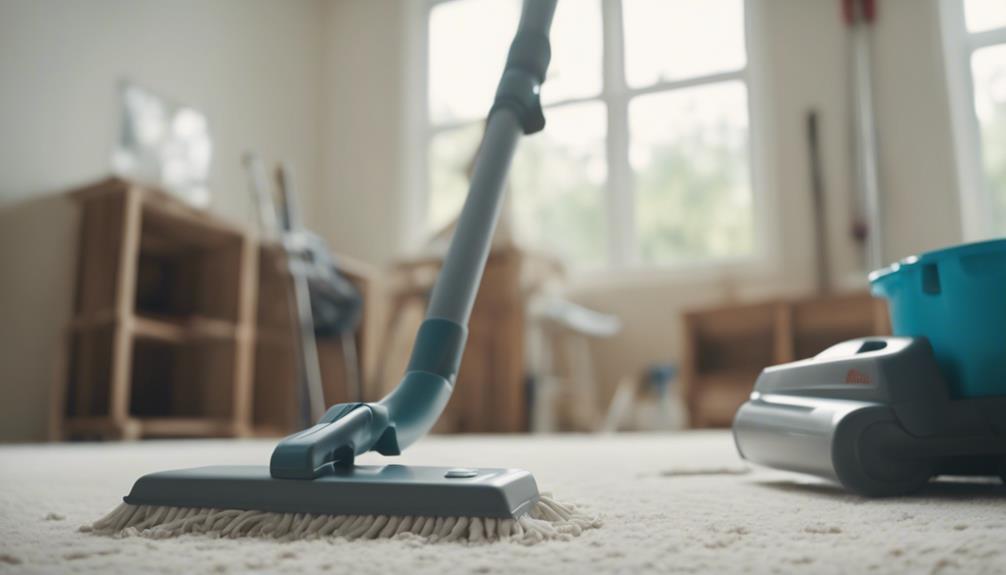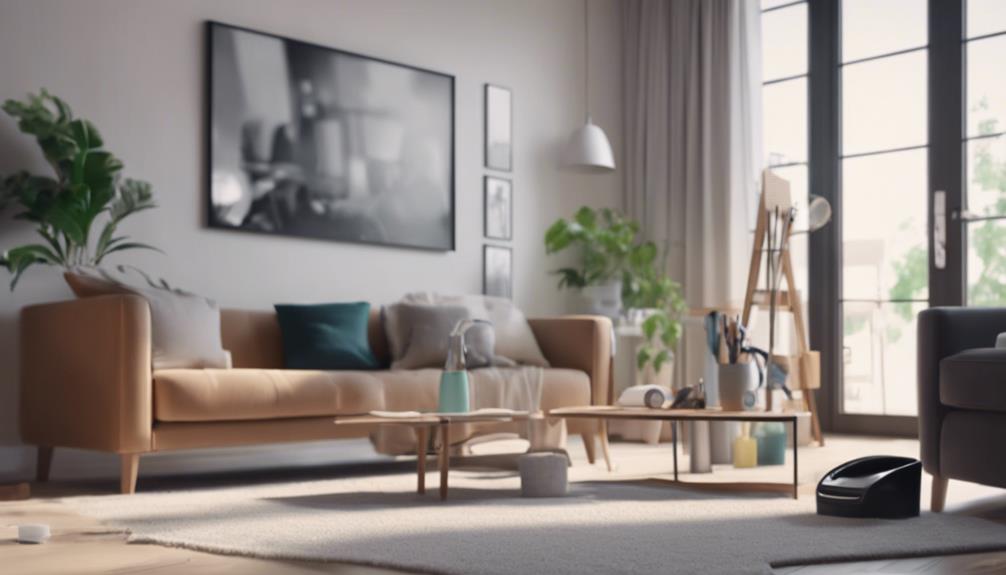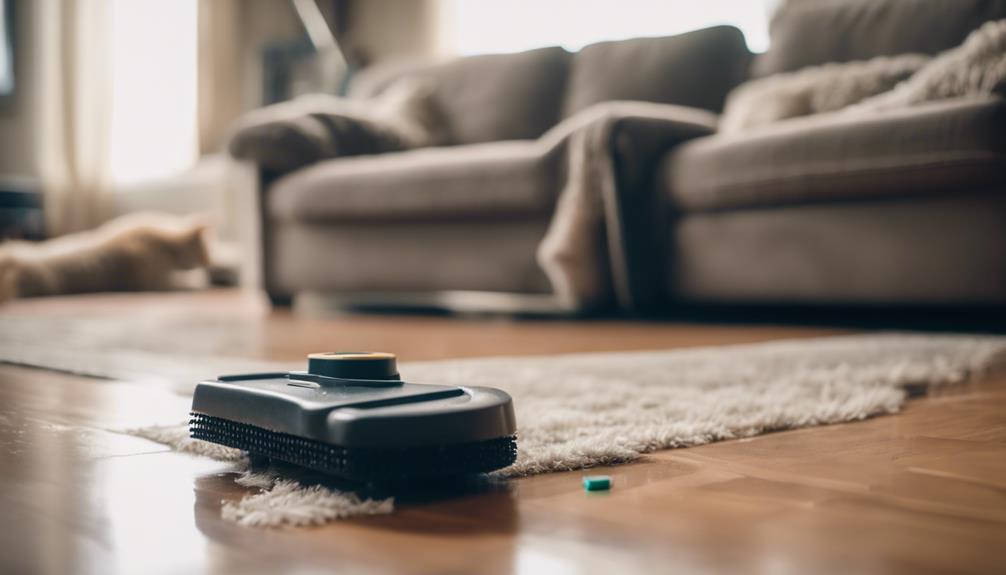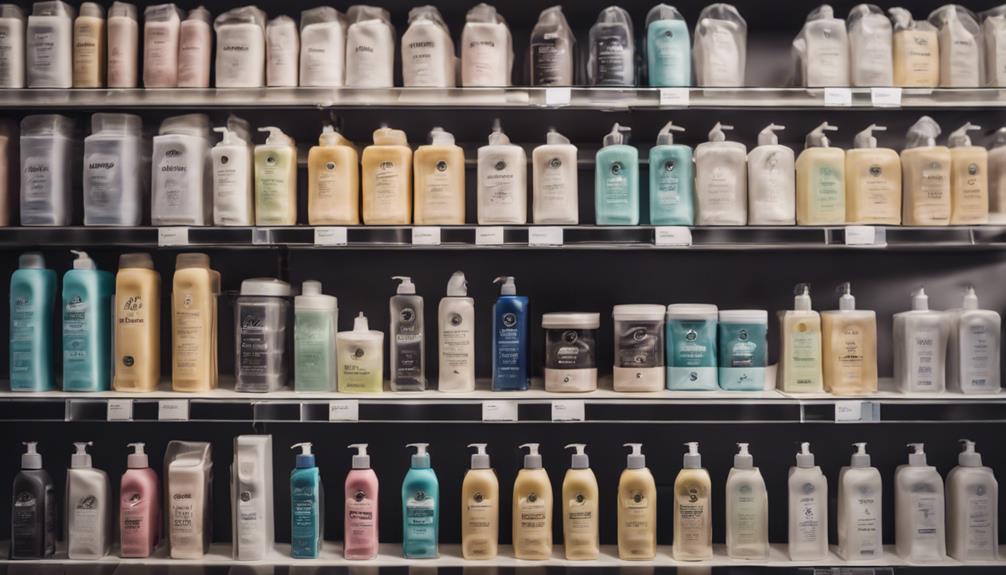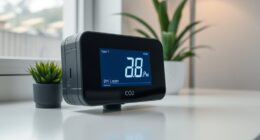To allergy-proof your home during summer, choose a vacuum with a HEPA filtration system to trap pollen, mold spores, and dust mites effectively. Use it regularly with proper techniques, like vacuuming slowly and reaching into corners. Keep filters and bags fresh and replace them when needed. Sealing gaps and using air purifiers also help reduce indoor allergens. Continue exploring for more tips to create a healthier, allergy-free space all season long.
Key Takeaways
- Use a vacuum with a HEPA filter and sealed system to effectively trap allergens like pollen, dust mites, and pet dander.
- Vacuum slowly and methodically, using attachments to reach corners and tight spaces for comprehensive allergen removal.
- Regularly check and replace filters and bags to maintain optimal suction and prevent allergen escape.
- Keep indoor humidity below 50% and wash bedding in hot water to reduce dust mites and mold growth.
- Seal cracks around windows and doors to prevent outdoor pollen and mold spores from entering your home.
Understanding Common Allergens During Summer
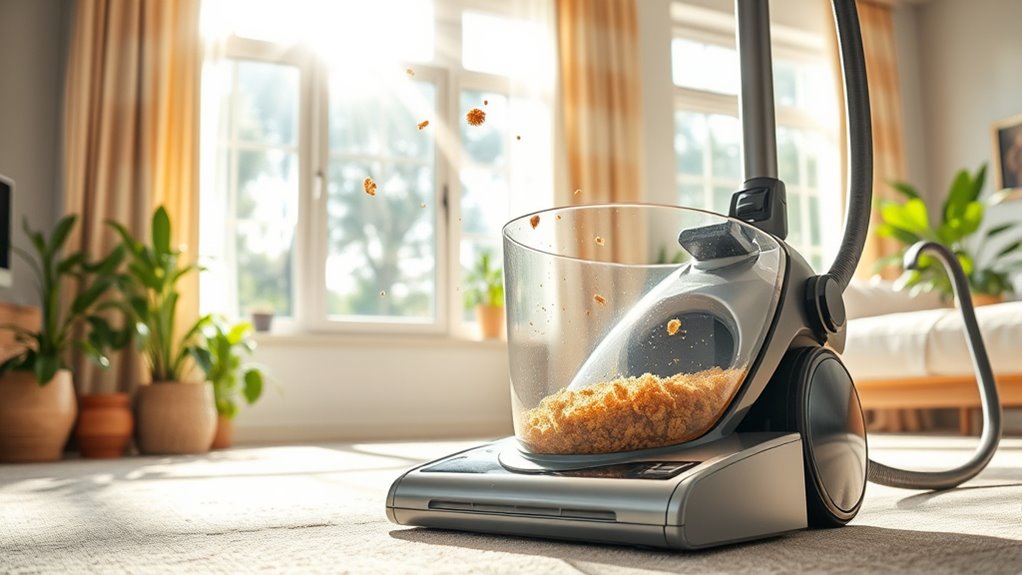
Summer brings an increase in allergens that can trigger your allergies, making it essential to understand what you’re dealing with. During this season, seasonal pollen becomes one of the main culprits, floating through the air and settling on surfaces. You might notice your symptoms worsen when outdoors or after opening windows. Mold spores also thrive in warm, humid conditions, often growing on damp surfaces like bathroom tiles, basements, or poorly ventilated areas. These tiny spores become airborne and are easily inhaled, causing allergy flare-ups. Knowing how these allergens affect you is vital for managing your symptoms. By understanding the sources of seasonal pollen and mold spores, you can take targeted steps to reduce your exposure and create a healthier indoor environment. Automation in business innovations can also assist in maintaining cleaner air quality through smart cleaning devices. Implementing air purifiers with HEPA filters can further reduce tiny airborne particles and allergens indoors. Additionally, regular cleaning and ventilation can significantly decrease mold growth in your home, especially in humid areas.
The Importance of a HEPA Filtration System
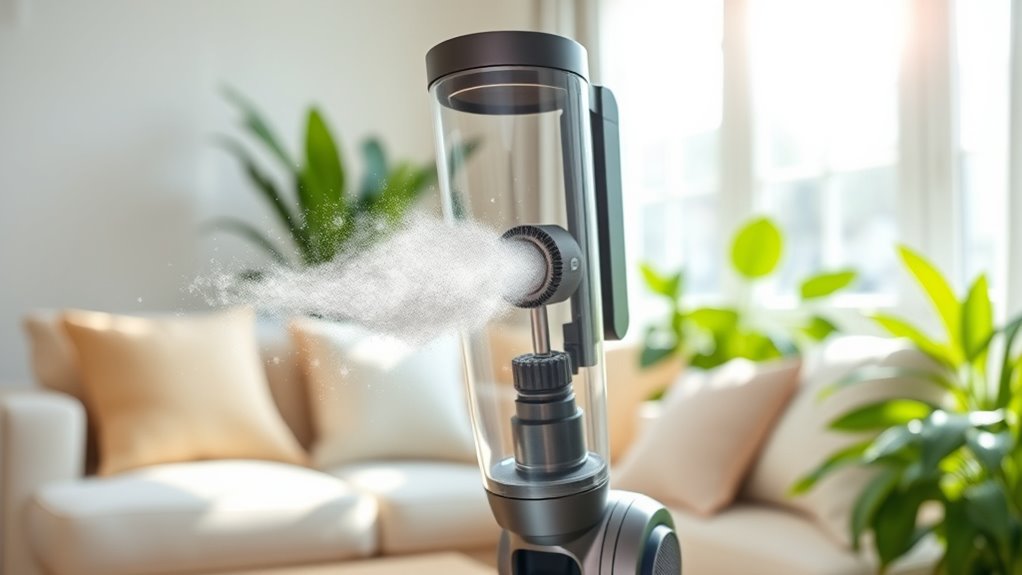
A high-quality air filtration system can make a significant difference in reducing airborne allergens inside your home. A HEPA filter captures tiny particles like pollen, dust mites, and pet dander, preventing them from recirculating. Proper HEPA maintenance guarantees peak performance, extending the filter’s lifespan and maintaining air quality. When choosing vacuum bags or filters, opt for allergy-proof fabrics that trap allergens effectively. Regularly replacing or cleaning your HEPA filter is essential to avoid mold and bacteria buildup. Additionally, consider these tips:
- Schedule routine HEPA filter replacements
- Use vacuum attachments for upholstery and curtains
- Keep vents and air returns clean
- Seal gaps around windows and doors
- Select fabrics that resist dust and allergens
- Be aware of allergen buildup and address it promptly to maintain a healthy environment
- Ensuring proper air purifier maintenance can significantly enhance allergen removal efficiency.
- Regularly inspecting and cleaning vacuum filters ensures optimal performance and allergen capture.
Types of Vacuums Ideal for Allergy Sufferers
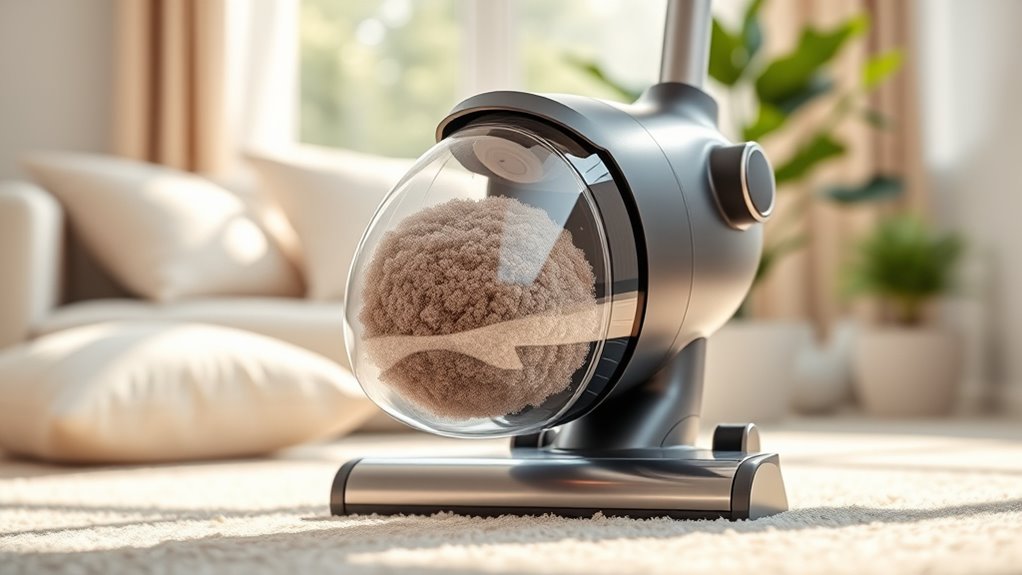
When choosing a vacuum for allergy relief, consider models with HEPA filter technology, as they trap tiny allergens effectively. You’ll also want to decide between bagged and bagless options, since each has pros and cons for containment and maintenance. Understanding these differences helps you pick a vacuum that keeps your home allergen-free. Additionally, selecting a vacuum with a high filter efficiency rating can further improve your indoor air quality by capturing even the smallest particles. To ensure optimal performance, check if the vacuum has certified allergy-friendly features that meet industry standards for allergen filtration. Opting for models with HEPA filters certified for allergen removal can provide extra assurance of effective filtration. Being aware of industry certification standards can help you identify truly effective allergy-reducing vacuums.
HEPA Filter Technology
Have you contemplated how HEPA filter technology can make a difference in your allergy management? HEPA filters trap at least 99.97% of airborne particles, including pollen, dust mites, and pet dander, making them ideal for allergy sufferers. When choosing a vacuum, look for models with HEPA filters that are compatible with air purifiers and have undergone allergen testing to ensure effective allergen removal. These vacuums prevent allergens from recirculating into your home’s air, reducing allergy symptoms. Additionally, lifevest advisors recommend selecting vacuums constructed with personal finance management techniques that minimize synthetic chemical emissions, further improving indoor air quality. Staying informed about legislative changes related to allergy-friendly home improvements can help you make better purchasing decisions and ensure your home remains a healthier environment. Incorporating air filtration standards into your cleaning routine enhances overall air quality and supports allergy relief efforts.
Bagged vs. Bagless Models
Choosing between bagged and bagless vacuum models can substantially impact your allergy management, as each type offers distinct advantages and challenges. Bagged vacuums trap allergens more effectively, reducing airborne dust during vacuum maintenance and minimizing allergy symptom management issues. They’re ideal if you want a sealed system that keeps dust out of the air. Conversely, bagless models are easier to empty and maintain, but they can release fine particles if not emptied carefully. For allergy sufferers, a bagged vacuum often provides better containment, leading to cleaner air and less exposure to allergens. When selecting a vacuum, consider how each type handles allergen containment and ease of maintenance, as these factors directly influence how effectively you can control allergy symptoms at home. Additionally, using vacuum models with replacement filters can further enhance allergen trapping and improve overall air quality.
Features to Look for in an Allergy-Friendly Vacuum
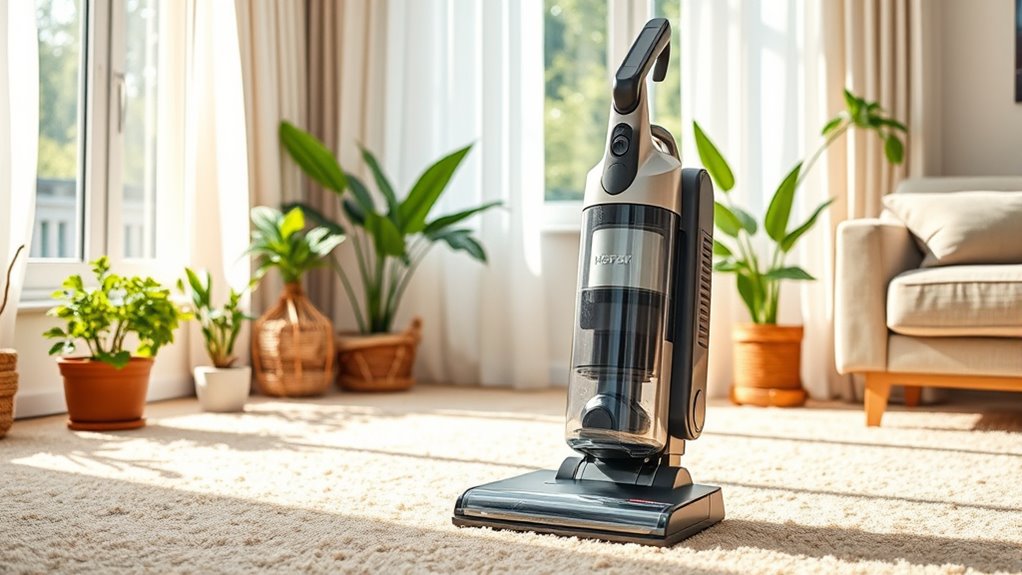
When choosing an allergy-friendly vacuum, look for a HEPA filtration system to trap tiny particles effectively. You should also consider the sealant and bag design, which prevent allergens from escaping back into the air. Additionally, adjustable suction power allows you to customize cleaning for different surfaces and allergen levels.
HEPA Filtration System
A HEPA filtration system is essential for allergy-proofing your home because it captures tiny particles that trigger allergic reactions. It traps pollen, pet dander, dust mites, and mold spores, improving indoor air quality. When choosing a vacuum, look for models with air purifier integration to enhance overall air cleaning. Consider how the vacuum handles different flooring types—carpet vs. hardwood—as HEPA filters are especially effective on carpets where allergens tend to settle.
Key features to evaluate include:
- Sealant tightness to prevent allergen leaks
- Compatibility with air purifier systems
- Filter replacement indicators
- HEPA filter lifespan
- Ease of maintenance and cleaning
A high-quality HEPA filter guarantees you breathe easier and creates a healthier living environment during allergy season.
Sealant and Bag Design
To effectively contain allergens, it’s essential to pay attention to the sealant and bag design of your vacuum. Look for models with high sealant durability, ensuring they maintain a tight seal over time without cracking or losing effectiveness. A durable seal prevents dust and allergens from escaping during use. Additionally, prioritize vacuums with innovative bag designs that minimize leaks and are easy to empty without releasing debris. Advanced bag design innovation often includes secure closures and smooth interiors that prevent allergen buildup. These features help keep allergens trapped inside, reducing airborne particles and improving overall air quality in your home. By choosing a vacuum with robust sealant and thoughtfully engineered bags, you’ll enhance your allergy protection and breathe easier during the summer months.
Adjustable Suction Power
Adjustable suction power is a crucial feature to look for in an allergy-friendly vacuum because it allows you to customize cleaning intensity based on your needs. With this feature, you can switch between gentle and powerful modes, ensuring thorough dust removal without damaging delicate surfaces. This flexibility helps with vacuum maintenance by preventing unnecessary wear and tear. An ergonomic design combined with adjustable suction makes handling easier, especially during extended cleaning sessions. Look for vacuums that offer precise control over suction levels to target allergens effectively. Additionally, adjustable suction helps conserve energy and prolong the vacuum’s lifespan. Keep in mind, a versatile vacuum with this feature ensures you can adapt to different surfaces and allergen levels effortlessly.
Tips for Proper Vacuuming Techniques
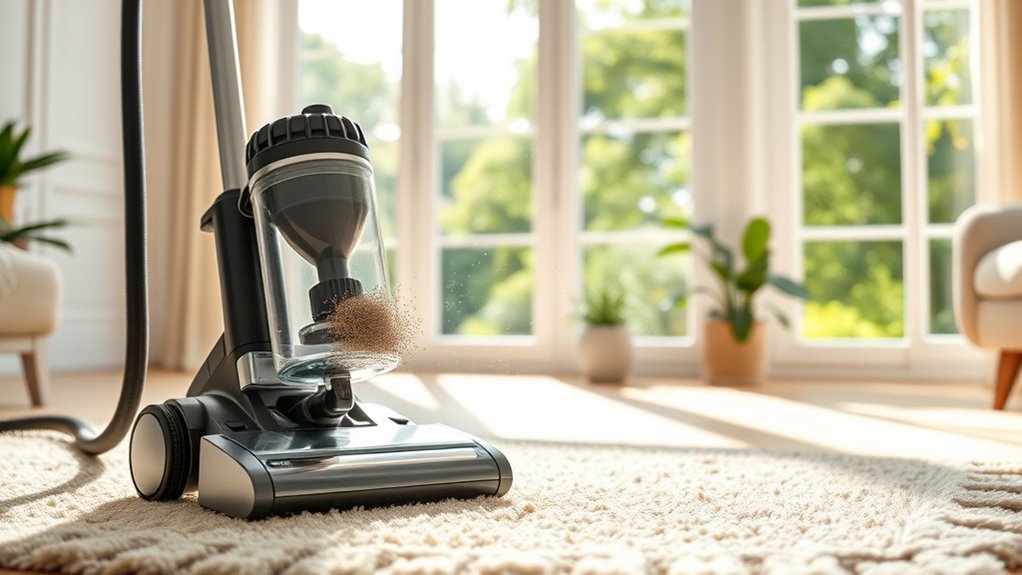
Proper vacuuming techniques are essential for effectively reducing allergens in your home. To do this, verify you perform regular vacuum maintenance, including checking for clogged filters and replacing worn brushes. When carpet cleaning, move your vacuum slowly and methodically, overlapping each pass to pick up embedded dust, pet dander, and pollen. Use the right attachments, such as crevice tools, to reach corners and tight spaces where allergens tend to accumulate. Always vacuum in multiple directions to loosen and lift debris thoroughly. Empty the vacuum bag or canister frequently to maintain suction power. Avoid rushing; consistent, deliberate movements maximize allergen removal and improve air quality, especially during summer allergy season. Proper techniques help keep your home cleaner and healthier for you and your family.
Maintaining and Replacing Vacuum Filters and Bags
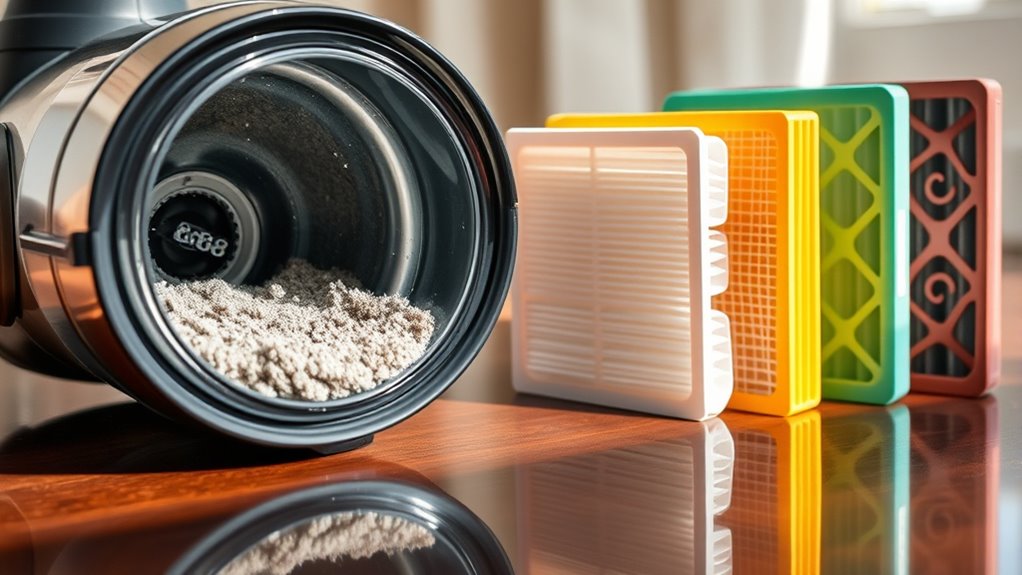
Regularly maintaining and replacing your vacuum filters and bags is essential for peak allergen removal. Proper vacuum filter maintenance ensures allergens are trapped effectively, preventing them from recirculating into your home. Replacing vacuum bags when they’re full prevents loss of suction and avoids dust escape. To keep your vacuum working at its best, consider these tips:
- Check filters monthly and clean or replace as needed
- Replace vacuum bags when they’re half full or full
- Use manufacturer-recommended filters for best results
- Inspect for damage or clogs during filter maintenance
- Store spare bags and filters in a clean, dry place
Consistently caring for your vacuum’s filters and bags enhances allergen capture, helping you breathe easier during allergy season.
Additional Measures to Reduce Allergens at Home
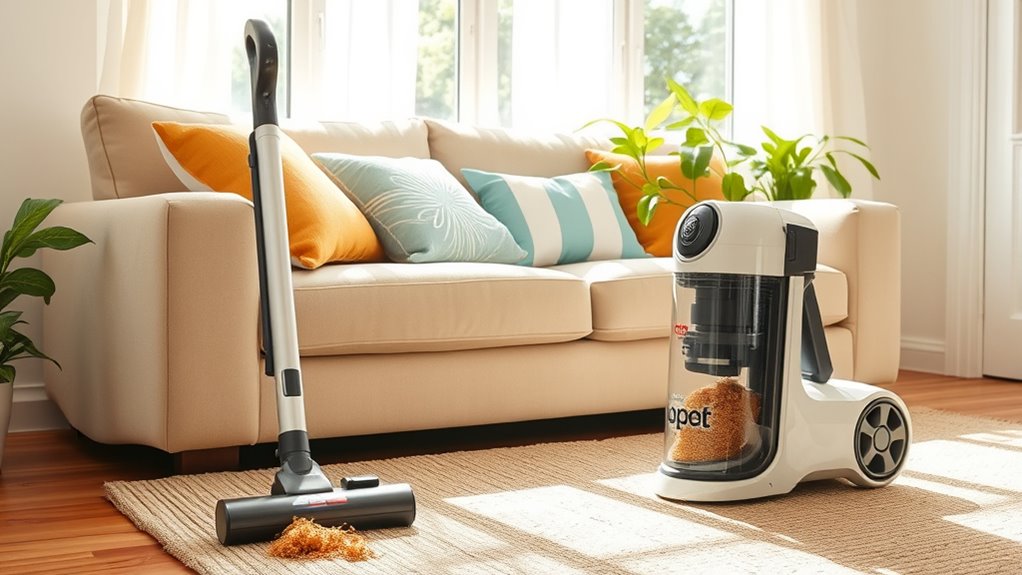
In addition to maintaining your vacuum filters and bags, implementing other strategies can substantially cut down airborne allergens in your home. Using air purifiers with HEPA filters helps trap tiny particles like pollen, pet dander, and dust mite debris, improving air quality. Regularly washing bedding in hot water eliminates dust mites and their allergens, reducing their presence in your environment. Keep humidity levels below 50%, as dust mites thrive in damp conditions. Consider sealing cracks and gaps around windows and doors to prevent outdoor allergens from entering. Vacuum carpets and upholstery frequently with a HEPA-equipped vacuum, and wipe surfaces to remove settled dust. These measures work together to create a less allergenic environment, helping you breathe easier during allergy season.
Comparing Popular Vacuum Models for Allergy Relief
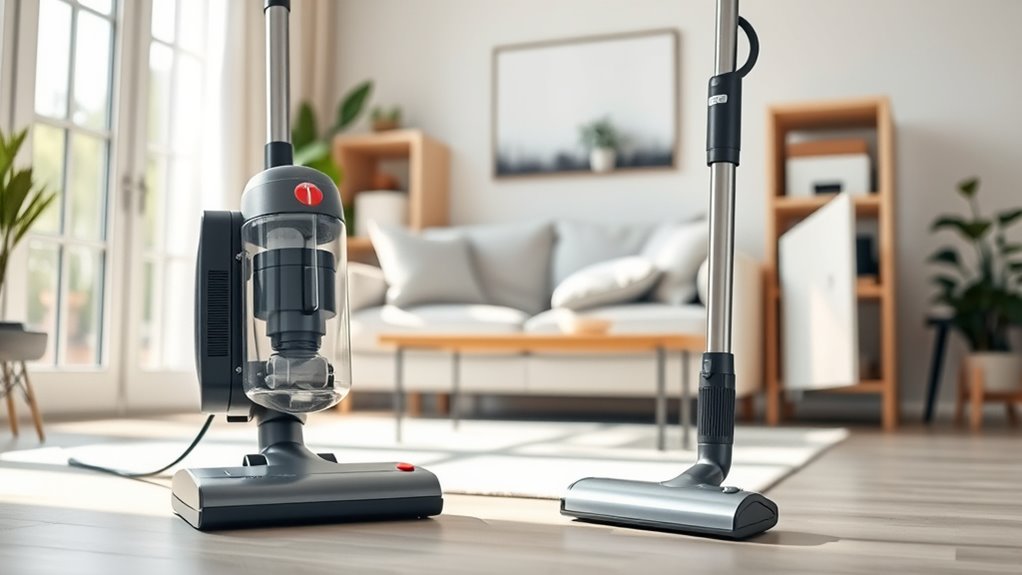
When choosing a vacuum to help with allergy relief, it’s important to compare models that prioritize HEPA filtration, strong suction, and easy maintenance. HEPA filters trap pet dander, pollen, and other allergens effectively, preventing them from recirculating. Look for vacuums with adjustable suction settings to handle different surfaces and allergen levels. Consider models with sealed systems that prevent leaks and ensure allergen containment. Lightweight designs improve maneuverability for thorough cleaning. Features like easy-to-empty dustbins reduce exposure during disposal. Additionally, check for:
- HEPA filtration systems for pet dander and pollen removal
- Powerful suction capabilities
- Sealed, airtight systems
- Easy-to-clean filters and dustbins
- Lightweight, ergonomic design
Choosing the right model guarantees you effectively reduce airborne allergens and maintain a healthier home environment.
Making Your Home a Comfortably Allergic-Free Space
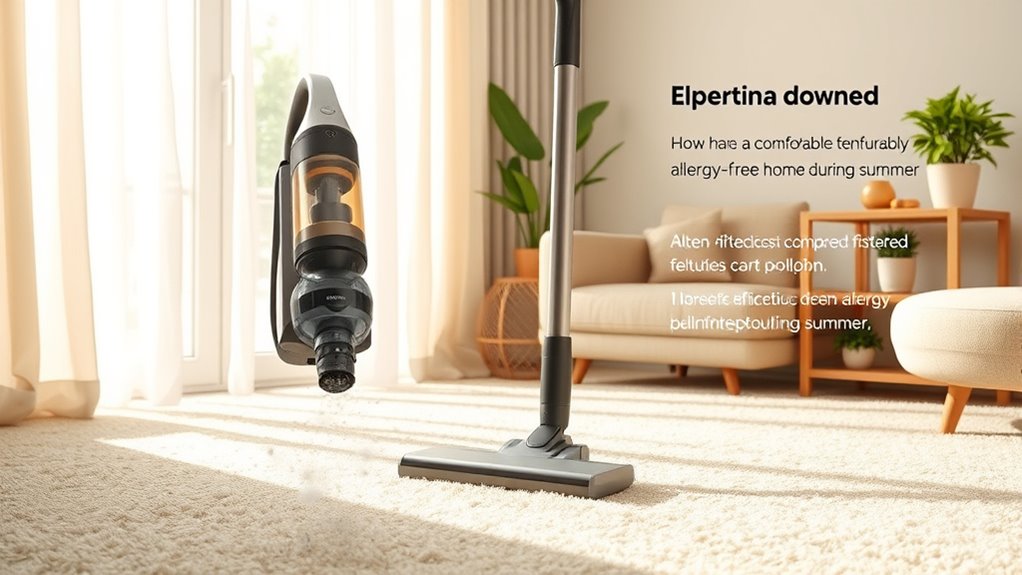
Choosing the right vacuum is a great first step, but creating an allergy-friendly home involves more than just cleaning tools. To truly reduce allergens, add an air purifier with a HEPA filter to your living space, trapping airborne particles and improving air quality. Keep windows closed during high pollen seasons and consider allergy medications if symptoms persist. Regularly wash bedding, curtains, and plush toys to eliminate dust mites and mold. Declutter your home to reduce dust accumulation and ensure proper ventilation. Using an air purifier alongside your vacuuming routine helps remove lingering allergens, making your environment more comfortable. With these steps, you’ll create a space where allergens are minimized, and relaxation is easier to enjoy during the summer months.
Frequently Asked Questions
Can Vacuuming Alone Eliminate All Summer Allergens?
Vacuuming alone can’t eliminate all summer allergens, but it makes a significant difference. Regularly vacuum with a HEPA filter to target pet dander and pollen removal from carpets, upholstery, and floors. To maximize allergy relief, complement vacuuming with other measures like washing bedding and keeping windows closed. This combined approach helps reduce allergen buildup and improves indoor air quality, making your home more comfortable during allergy season.
How Often Should I Vacuum to Reduce Allergens Effectively?
Imagine your home as a garden where allergens are weeds. To keep it pristine, you need regular vacuum maintenance. Vacuum at least twice a week to prevent allergen buildup and keep your indoor air clean. If you have pets or allergies, consider vacuuming more often. Consistent cleaning acts like a gardener’s hands, uprooting allergens before they can spread and cause trouble, helping you breathe easier and stay healthier.
Are Cordless Vacuums Suitable for Allergy Sufferers?
Cordless vacuums are a great choice for allergy sufferers because of their cordless convenience, allowing you to easily reach all areas without hassle. Look for models with allergy-friendly design features, like HEPA filters, to trap tiny allergens effectively. Their lightweight, portable nature makes cleaning quicker and more thorough, helping you reduce allergens in your home. Overall, cordless vacuums can be highly suitable if they’re equipped with the right filters and features.
What Is the Best Storage Method for Vacuum Filters and Bags?
Imagine finding a dusty filter months later—disorganized storage can cause spills and dust escape. To avoid this, use vacuum filter storage containers or resealable bags to keep filters dust-free and easy to access. For bag storage solutions, opt for labeled, airtight containers that prevent dust exposure and damage. These methods guarantee your vacuum components stay clean, prolonging their lifespan and maintaining ideal allergy-proofing in your home.
Can Air Purifiers Complement Vacuuming for Allergy Relief?
Air purifiers definitely complement vacuuming by enhancing your home’s overall air quality. Their benefits include removing airborne allergens like pollen, pet dander, and dust mites, which vacuuming might miss. Using both together, you improve vacuum air quality and reduce allergy triggers, giving you cleaner, healthier indoor air. This combined approach helps you breathe easier, especially during allergy season, ensuring your home stays as allergen-free as possible.
Conclusion
By choosing the right vacuum and staying diligent, you can turn your home into a haven from summer allergens. But the real question is, are you ready to take the next step? With these tips and the perfect vacuum, you hold the power to transform your space—and your health. Don’t wait until allergies take over. The secret to relief might be just a vacuum away—are you prepared to make that change today?
